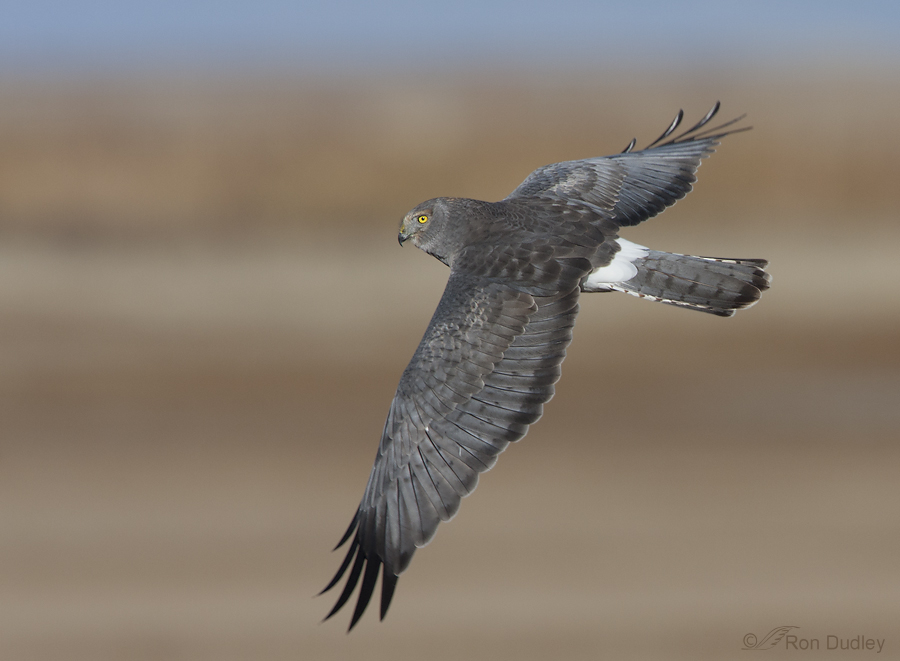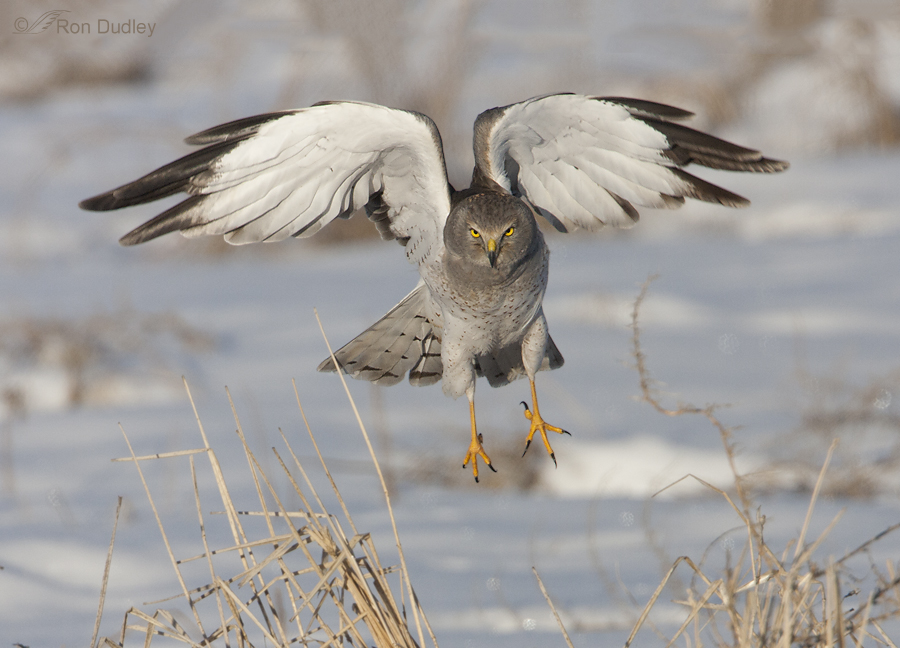One of my favorite subjects is the male Northern Harrier. This species is strongly sexually dimorphic, both in color and in size. Adult males are mostly white below and gray above with black wing-tips. Adult females are buffy with streaks of brown below and brown above. Females are larger and almost 50% heavier than males. Because juveniles of both sexes are similar to the adult female, to the untrained eye most harriers look like females which is one of the reasons that many folks believe that they rarely see males – thus the name “Gray Ghost” for the “elusive” adult male.
1/1600, f/8, ISO 400, 500 f/4, 1.4 tc, natural light, not baited, set up or called in
Even though this bird is slightly past me I think the look back at me compensates for that and I like the topside view of the wings and tail.
1/3200, f/8, ISO 500, 500 f/4, 1.4 tc, natural light, not baited, set up or called in, canvas added for composition
When I’m lucky enough to have one of these harriers take off in my direction they often give me an almost defiant or challenging look, probably enhanced by those bright lemon-yellow eyes.
I’ve always had a “thing” for harriers, either sex and any age. But I’ll admit to having a particular fondness for photographing the adult males.
Ron




Beautiful bird, awesome photos.
Such a penetrated gaze. I like all of the raptors but this is a stunning bird hitherto unknown to me. I am really enjoying the education I receive from ALL of your posts. Thank you so much.
Thank you, Elephant’s Child.
Love your blog! Not only do you show fantastic pictures, but I also appreciate the insight about the subject and its behavior. Do you already have all of these pictures through years of bird watching? Or do you blog about whatever pictures you took that day? One day, I hope to live the life!
Chris, Some of the images I post on my blog are older and others are very recent. I go out photographing birds on most mornings that have good light.
Oh man, your images blow me away! I love that lead shot! What a gorgeous bird!
Thank you, Chuck.
I can see why you like these Harrier’s. I remember seeing my first male Harrier along the San Pedro River. At first all we saw was white then it turned to show it’s gray top. Wonderful images and post Ron, enjoyed it.
Thanks, Jim. Harriers can be a blast when you can get close enough to them. And in the right light the males certainly can look almost white at certain angles.
That grey is beautiful, I’d never seen one so grey!
Maria, Younger males in transition have less gray but yes, the grays of adult males are stunning.
Both of these are wow! photos, but I appreciate the first photo because it shows so clearly the distinctive identifying markers. It is taken from an unusual perspective. I’ve had the pleasure of seeing a couple of Northern Harriers recently, and was able to identify them pretty easily, but it would have been nice to have this photo.
I’m glad you appreciate the unusual perspective in that first shot, Susan. That appealed to me too.
My wife and I use to enjoy seeing these beautiful raptors in Ma. at the Parker River Wildlife Refuge, just sailing low over the tall grass seeking sustenance.Thank you Ron for the beautiful photos and info !
And thank you for the nice comment, John.
Oooh can’t wait to see the food transfer– I hope you get that one These two shots are stunning (again, as usual LOL). The colors and texture play offer me so much. The bird looks quite innocuous in the first shot, but watch out! in the second! And, how come you always manage to find the birds with perfect intact flight feathers and tails?
These two shots are stunning (again, as usual LOL). The colors and texture play offer me so much. The bird looks quite innocuous in the first shot, but watch out! in the second! And, how come you always manage to find the birds with perfect intact flight feathers and tails? 
Believe me, Chris – I get my share of birds with missing or scruffy feathers. Sometimes more than my share…
Regal bird, lovely shots. The feet in the second shot are a great eye catcher. Thanks!
I like those feet (and legs) too, Tana – they’re so distinctively yellow.
Hi Ron,
I know that you pride yourself on not setting up the sot, but if you are ever so inclined, it is fairly easy to call a Marsh Hawk to you using a call that immitates a mouse like the ones used to call coyotes. If I am still, I can usually get them within a few meters of me. They always seem surprised to find a 260 lb “mouse” when they do finally locate the source of the sound!
Great pictures!
Mark
Rats! misspelled my own name. It is too early in the morning!
Mark RunneLs
Thanks for the tip, Mark but you’re right, I don’t bait, set up or call in. For me it’s a matter of ethics in nature photography. I know that other photographers have differing views…
Can’t wait to see those shots!!
If I wasn’t such a homebody New Englander, your shots could make me want to move out west! What a great place for some excellent images. I’m still enamored over the set of Long-tailed Weasel pictures you shot! Those images hooked me to your blog along with kudos to your philosophy!!
As a retired Biology teacher, the classroom is outside. Tried to do that as much as possible. Many thanks to you for taking the time to put this blog and submitting your pictures for all of us to see the beautiful work that you perform.
I can’t wait to GET “those shots”, Dick. Shooting birds “out west” is boom or bust in my experience. The last two months have been mostly bust for me I’m afraid. It’s just now starting to pick up a little.
Delightful shots and comments!
Thanks, Charlotte
Wow! What fabulous images. I love these beautiful birds. I never seem to get close enough to them to get a good look at them. Thanks!
They’re often difficult for me to approach too, Sharon. Add to that the fact that I’m convinced that they instinctively put themselves between me and the sun when they’re flying which ruins the lighting of course…
Damn Ron, those are fantastic shots!! I would love to shoot some shots that are just half as good as these!!
Wonderful, clear, spot-on focus and composition (to me). I rarely see the male, and when I do it is fleeting.
Great job and what a joy to have those shots in your database.
Thanks a lot, Dick. I wish you luck with the adult male. I usually get my best opportunities with harriers during winter but I’ve located a probable nesting pair (only seen the female so far) in an area where they’ve nested before so I have high hopes (probably too high) of getting some shots of the mid-air food transfer this spring.